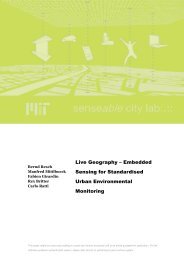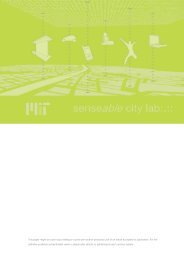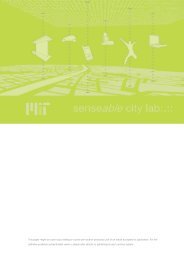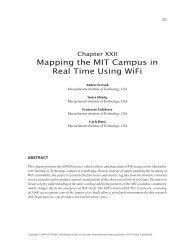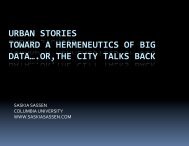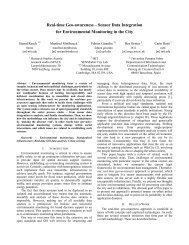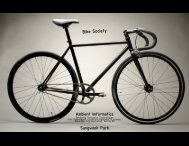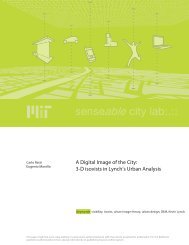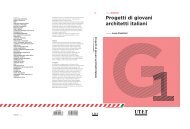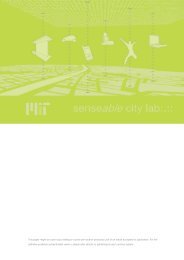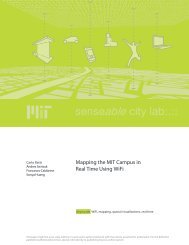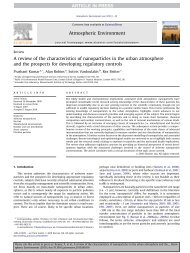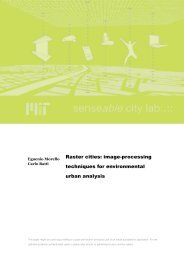Today - MIT SENSEable City Lab
Today - MIT SENSEable City Lab
Today - MIT SENSEable City Lab
Create successful ePaper yourself
Turn your PDF publications into a flip-book with our unique Google optimized e-Paper software.
User-Generated Content<br />
foreign—who used a mobile phone at<br />
a given point in the city and at a given<br />
moment. We couldn’t identify individual<br />
users in any way based on the data<br />
that we collected and analyzed, and,<br />
consequently, we avoided the significant<br />
privacy issues that other methodologies<br />
have raised. 10<br />
From a methodological perspective,<br />
the data we analyzed<br />
in this article has a clear advantage<br />
over more traditional<br />
location data obtained through controlled<br />
studies in which subjects carried<br />
sensors and were thus aware of<br />
being tracked. Although we couldn’t<br />
determine the sample used, our mobile<br />
phone data covers the usage habits of<br />
more than 1 million people and thus<br />
represents a step-change in the scale of<br />
localizable data-collection efforts.<br />
These collection methods also contain<br />
several important potential advantages<br />
over other pervasive tracking<br />
systems. Solutions that require people<br />
to carry a separate GPS-enabled device<br />
not only remind users that their<br />
movements are being followed—which<br />
might encourage them to pursue highbrow<br />
activities during their visit—but<br />
also generate fatigue effects and don’t<br />
always function well in urban areas<br />
because of signal multipath and urban<br />
canyon obstructions. The alternative<br />
of a distributed, but fixed, web of sensors<br />
entails onerous maintenance and<br />
data-transmission costs. These issues<br />
strongly suggest that the research community<br />
should investigate and evaluate<br />
the use of these new data types as well<br />
as consider approaches that don’t rely<br />
on the deployment of ad hoc and costly<br />
infrastructures.<br />
Our results demonstrate that further<br />
development is required to validate<br />
our observations and gain new<br />
insights into factors such as a space’s<br />
temporal usage-signature, its attractiveness<br />
to different groups of people,<br />
and the degree of similarity to usage of<br />
other spaces.<br />
The explicit character of photo geotagging<br />
and manual disclosure provides<br />
additional dimensions of interest; positioning<br />
a photo on a map isn’t simply<br />
adding information about its location,<br />
it’s an act of communication that embodies<br />
locations, times, and experiences<br />
that individuals consider to be relevant<br />
to themselves and others. There is a real<br />
richness to the intentional weight that<br />
people attach to disclosing their photos,<br />
and the results clearly show that Flickr<br />
users have a tendency to point out the<br />
highlights of their visit while skipping<br />
over their trip’s lowlights.<br />
Still, our analysis and visualization<br />
are meant to complement, not replace,<br />
traditional surveys and other means of<br />
data collection. In the predigital age,<br />
tourism officials could know how many<br />
visitors spent a night in a hotel, but now<br />
we can also use feedback mechanisms<br />
on public Web sites to estimate how<br />
Our analysis and visualization<br />
are meant to complement, not replace,<br />
traditional surveys and data collection.<br />
much they enjoyed their stay. Similarly,<br />
we could know how many tourists visited<br />
a given attraction, but now we can<br />
also infer their experiences by their uploaded<br />
pictures and semantic descriptions.<br />
Direct observation lets us know<br />
the number of tourists in an area, but<br />
through the mobile phone network, we<br />
can know their nationalities.<br />
The shortcomings of single-site ticket<br />
sales as a correlating data set requires us<br />
to pursue alternate strategies for relating<br />
our mobile and photographic data<br />
to real-world activity with traditional<br />
surveys. An additional research avenue<br />
is understanding the circumstances under<br />
which users tag their content at a<br />
street level or when they’re tagged to<br />
a larger region. An initial analysis of<br />
our Flickr data set suggests that the 123<br />
German users tended to provide more<br />
accurate locational information than<br />
their 175 Spanish counterparts.<br />
The results of further analysis might<br />
reveal distinct profiles of georeferencing<br />
and geotagging photos. These profiles<br />
might be based on culture or nationality,<br />
the type of tourist in terms of<br />
their length of stay or familiarity with<br />
the city, their level of technical expertise<br />
or spatial orientation ability, and<br />
the type of task or environment visited.<br />
Other questions we need to consider<br />
relate to the types of situations during<br />
which users are more or less likely<br />
to use their mobile devices for data<br />
generation. Answers to these types of<br />
questions should help us better define<br />
the meaning of the data and further<br />
explore their potential usage in social<br />
sciences and urban studies.<br />
Acknowledgments<br />
We thank Barcelona Media and Telecom Italia for<br />
their support and Telespazio for satellite digital<br />
imagery. Also, we’re indebted to many people at<br />
the Massachusetts Institute of Technology and<br />
the Universitat Pompeu Fabra for providing extremely<br />
stimulating research environments and<br />
for their generous feedback. In particular, thanks<br />
to Assaf Biderman, Liang Liu, Nicolas Nova, Jon<br />
Reades, and Andrea Vaccari for letting us pick<br />
their brains. Of course, any shortcomings are our<br />
sole responsibility.<br />
References<br />
1. E. O’Neill et al., “Instrumenting the <strong>City</strong>:<br />
Developing Methods for Observing and<br />
Understanding the Digital <strong>City</strong>scape,”<br />
Proc. 8th Int’l Conf. Ubiquitous Computing<br />
(Ubicomp 2006), LNCS 4206,<br />
Springer, 2006, pp. 315–332.<br />
2. M.F. Goodchild, “Citizens as Voluntary<br />
Sensors: Spatial Data Infrastructure in the<br />
World of Web 2.0,” Int’l J. Spatial Data<br />
Infrastructures Research, vol. 2, 2007,<br />
pp. 24–32.<br />
42 PERVASIVE computing www.computer.org/pervasive<br />
Authorized licensed use limited to: IEEE Xplore. Downloaded on December 4, 2008 at 08:13 from IEEE Xplore. Restrictions apply.



